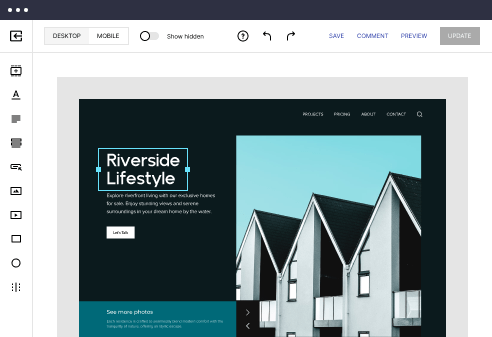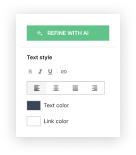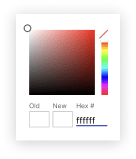
React.js optimized service unavailable page template
Explore Similar TemplatesAbout template
Supercharge your service unavailable page with React.js for outstanding performance! Learn more today.
Recommended templates
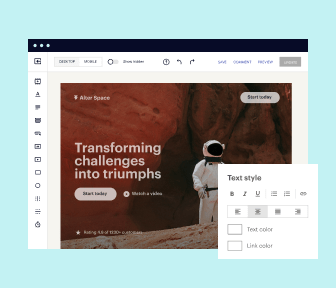
Easy to build without coding
With the intuitive drag-and-drop builder, anyone on your team can create high-converting pages without any knowledge of code or design. Make enhancements to your landing page with custom widgets using Javascript, HTML/CSS, or third-party scripts.
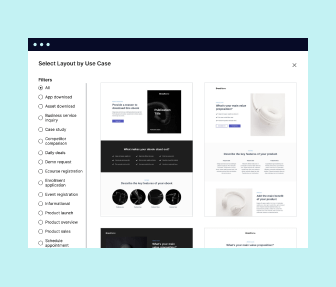
Multiple layouts for any industry and goal
Select from 500+ landing page layouts built to boost conversions across industry-specific scenarios. Customize them by adjusting fonts, adding images, and generating on-brand content with the AI assistant. Quickly scale with Instablocks® and Global Blocks that you can save, reuse, and update globally.

Loads fast and looks polished on any device
Every template is responsive, which means they present professionally on any device and load blazingly fast with our Thor Render Engine. You can also power them up with Google AMP technology to deliver an unparalleled mobile experience and drive higher conversions.
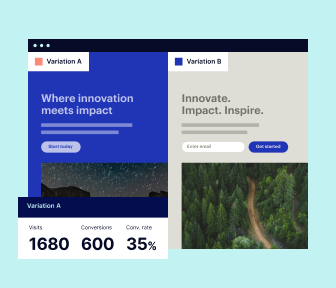
Robust analytics & experimentation
Get real-time updates and reporting across all your devices, showing the number of visitors, conversions, cost-per-visitor, and cost-per-lead. Launch AI-powered experiments, run A/B tests, and use heatmaps to analyze user behavior, then optimize your landing page to maximize conversions.
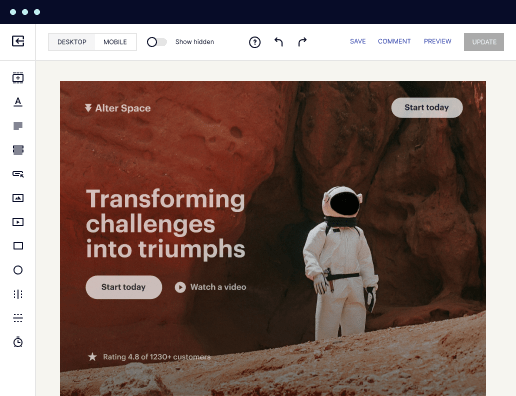
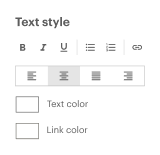
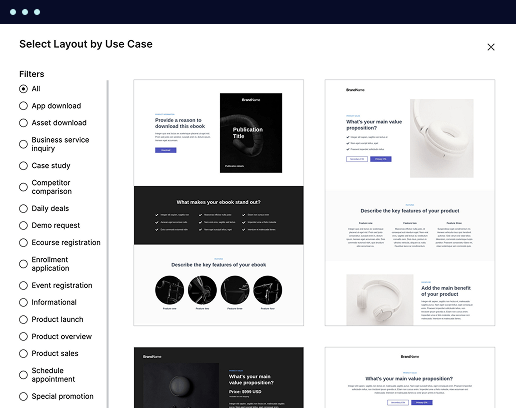


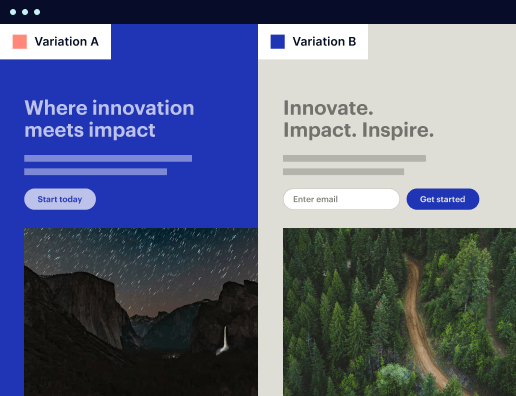
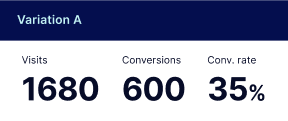
Easy to build without coding
With the intuitive drag-and-drop builder, anyone on your team can create high-converting pages without any knowledge of code or design. Make enhancements to your landing page with custom widgets using Javascript, HTML/CSS, or third-party scripts.
Multiple layouts for any industry and goal
Select from 500+ landing page layouts built to boost conversions across industry-specific scenarios. Customize them by adjusting fonts, adding images, and generating on-brand content with the AI assistant. Quickly scale with Instablocks® and Global Blocks that you can save, reuse, and update globally.
Loads fast and looks polished on any device
Every template is responsive, which means they present professionally on any device and load blazingly fast with our Thor Render Engine.
Robust analytics & experimentation
Get real-time updates and reporting across all your devices, showing the number of visitors, conversions, cost-per-visitor, and cost-per-lead. Launch AI-powered experiments, run A/B tests, and use heatmaps to analyze user behavior, then optimize your landing page to maximize conversions.
All the features you need to build lead-generating landing pages
Explore more featuresLearn how to build top-performing landing pages for any goal
FAQs
Leading the way in building high-performing landing pages





Maximizing your ROI with Instapage: A comprehensive guide to landing page optimization
If you're looking to enhance the effectiveness of your digital marketing strategies, using a powerful tool like Instapage is essential. With its capabilities for creating high-converting landing pages and an array of optimization features, Instapage stands out as the market leader. This guide walks you through the step-by-step process of utilizing Instapage to optimize your campaigns, tailored specifically for marketers in the USA across various sectors including business services and tech.
Understanding Instapage's capabilities
Instapage is more than just a landing page builder; it is a complete conversion rate optimization (CRO) platform. With over 100 high-converting templates at your disposal, you can create captivating landing pages that cater to your specific audience needs. This flexibility allows marketers to develop tailored experiences that resonate with diverse verticals in the USA.
- Customizable templates: Easily modify and adapt templates to fit brand aesthetics.
- Intuitive lead generation tools: Utilize elements designed to increase conversions from your landing pages.
- Built-in analytics: Track performance metrics to refine strategies based on real-time data.
Step 1: Building your landing page
The first step in leveraging Instapage effectively is to build your landing page. Begin by selecting a template from the extensive library that fits your campaign objectives. It’s important to consider your audience's preferences as you customize your page.
- Select a high-converting template that aligns with your marketing goals.
- Use the intuitive drag-and-drop editor to customize content, visuals, and call-to-action buttons.
- Incorporate targeted lead generation elements like forms and testimonials.
Step 2: Optimize for conversions
Once your page is built, the next step involves optimization to ensure maximum conversions. Instapage offers unique testing features that allow you to fine-tune your landing page based on user behavior.
- Implement A/B testing to compare different versions of your landing page.
- Use heatmaps to identify user engagement and adjust elements that may be underperforming.
- Analyze conversion rates and adjust strategies accordingly.
Step 3: Personalize user experiences
Personalization can significantly impact user engagement and conversion rates. Instapage allows you to deliver dynamic content tailored to different audience segments.
- Utilize dynamic text replacement to customize messaging based on user input.
- Align specific ads to dedicated landing pages to enhance relevance.
- Track audience-specific metrics to gain insights into user behavior.
By following these steps, you're well-equipped to maximize your marketing ROI with Convincing, high-converting landing pages on Instapage.
Don’t leave your digital marketing success to chance. Start using Instapage today to optimize your campaigns and witness substantial growth in your conversion rates.
People also ask about React.js optimized service unavailable page template
Creating a ReactJS Optimized Service Unavailable Page Template
Understanding the importance of an optimized service unavailable page
A service unavailable page, typically represented by the HTTP status code 503, is a crucial part of web application design. It signifies that the server is temporarily unable to handle the request due to a temporary overload or scheduled maintenance. Knowing why a service might become unavailable is vital; it can range from server failures and maintenance routines to unexpected spikes in traffic. This downtime can adversely affect user experiences and a site's overall reputation, as users often rely on seamless web interactions.
When users encounter downtime, the impact can extend beyond immediate frustration. It can lead to lost revenue opportunities, diminished user trust, and potential negative perceptions of the brand. An optimized service unavailable page serves as a bridge to maintain communication with users during problematic times, ensuring they stay informed and engaged.
Key features of a ReactJS optimized service unavailable page template
ReactJS is a powerful library that aids in building user interfaces with a focus on performance and responsiveness. With React's component-based architecture, it allows for seamless updates without needing a complete page reload. This is incredibly beneficial for service unavailable pages because immediate feedback can reassure users that the website is still attentive to their needs, even during downtime.
Incorporating visually appealing elements into a 503 page can turn a frustrating experience into a more graceful one. Examples could include an interactive graphic that shows the service status or a friendly message assuring users that efforts are underway to resolve the issue. Such features can significantly enhance the user experience, albeit briefly.
Seamless updates without full page reloads
Immediate feedback to users regarding service status
Customizable elements to maintain brand presence
Customizable design elements
The design of a service unavailable page should reflect the brand's identity while providing clear messaging. By integrating brand colors, typography, and even logos, companies can reinforce their presence even in times of service interruptions. Thoughtful design choices contribute significantly to user perception; for instance, using a calm color palette can help mitigate the frustration users might feel during outages.
Visual elements like animated graphics or engaging visuals can effectively retain user attention, guiding them to further actions like filling out a feedback form or visiting other areas of the site. These design choices can serve a dual purpose: keeping the brand in the user's mind while providing helpful information.
Alignment with brand guidelines for consistency
Usage of color schemes to manage user emotions
Incorporation of animated elements for engagement
Responsiveness across devices
In an increasingly mobile-driven landscape, ensuring that service unavailable pages are responsive across devices is paramount. Utilizing techniques such as fluid layouts and responsive design principles ensures that the page looks and functions well on screens of all sizes. ReactJS's flexibility allows developers to create components that can adapt to various device specifications, providing a consistent user experience.
Testing site performance across different devices maximizes user accessibility. Employing tools to gauge and optimize performance can help identify potential display issues before they impact users. By prioritizing mobile-friendly designs, brands can significantly mitigate negative experiences during downtimes.
Fluid layouts for effective scaling on varied screens
Utilizing ReactJS for adaptive components
Conducting performance tests to ensure accessibility
Technologies and tools for developing an effective service unavailable page
Using the ReactJS framework comes with numerous advantages, especially its component-based architecture, promoting modularity and easier maintenance throughout development. React's server-side rendering capabilities can enhance performance by loading pages faster during high traffic conditions. These characteristics are particularly valuable when a service is facing downtime, making it easier to manage user expectations.
Additionally, leveraging React hooks can simplify state management, allowing developers to create responsive feedback mechanisms during service interruptions, such as displaying dynamic messages sourced from APIs. Integrating these features helps personalize the communication with users, providing timely information that aligns with their previous interactions with the site.
Component-based architecture for easy updates
Server-side rendering advantages for performance
Utilizing hooks for better state management
Integrating with backend services
To further enrich the user experience during downtimes, integrating the service unavailable page with backend services is essential. It allows developers to fetch dynamic updates and messages from server APIs, keeping users informed about the service status. Personalized messages can significantly enhance user engagement, particularly if the service recognizes the user’s previous activity.
Real-time system health updates can also be displayed directly on the service unavailable page, letting users know whether the downtime is expected to be short-lived or prolonged. Such features foster a sense of transparency and connection between the service provider and users, mitigating potential frustration.
Fetching updates from server APIs for dynamic content
Personalizing user messages based on their data
Displaying real-time system health for transparency
Enhancing user engagement during downtime
Clear communication is key during downtimes. Implementing transparent messaging can alleviate user concerns. It's crucial to inform users about the issue at hand and what steps are being taken to rectify it, thereby reassuring them that their experience matters to the brand. By laying out the anticipated time frame for service restoration, brands can manage expectations more effectively.
Using empathetic language and recognizing the inconvenience caused can build trust even during challenging times. Being proactive in communication allows businesses to connect with users, turning potentially negative experiences into opportunities to build loyalty.
Importance of transparency in messaging
Strategies for reassuring users about service timelines
Building trust through empathetic communication
Collecting user feedback during outages
Listening to user feedback during outages can provide invaluable insights. Creating dedicated feedback forms that allow users to voice their concerns or questions ensures that they feel heard. Additionally, implementing Q&A sections on the service unavailable page can address common queries that might arise, further enhancing communication.
Analyzing this feedback can offer a competitive edge, helping brands understand pain points and preferred communication channels. Collecting insights during downtimes can contribute to a more informed approach to service improvements in the future.
Collecting user feedback through dedicated forms
Utilizing Q&A sections for common inquiries
Gleaning insights for future service improvements
Leveraging communities for problem resolution
Engaging with developer communities can also greatly enhance the problem-resolution process during downtimes. Participating in forums and discussions can yield innovative solutions and approaches to common issues. Collaborative efforts can minimize downtime durations while also enriching the knowledge base of developers involved.
By highlighting communities focused on ReactJS development, brands can foster a sense of belonging and encourage knowledge sharing, helping developers to learn from shared experiences and build more resilient systems.
Participating in forums for innovative solutions
Benefits of collaboration in troubleshooting
Highlighting communities centered on ReactJS
Creating a knowledge hub
Developing a knowledge hub with FAQs and troubleshooting guides can assist users during downtimes. This centralized resource can alleviate user frustration by providing immediate answers to common queries. Building a system that is easily navigable enhances the user experience.
Additionally, integrating machine learning tools for predictive analytics can offer insights about user behavior during downtimes. By preemptively understanding potential user concerns, businesses can improve their communication strategies and support mechanisms.
Developing FAQs to assist users
Creating a user-friendly centralized resource
Employing machine learning for predictive insights
Testing and optimizing the service unavailable page
Optimization of the service unavailable page is an ongoing process. Implementing A/B testing strategies allows brands to conduct controlled experiments that can significantly enhance the user experience of the 503 page. By analyzing user data and engagement metrics, brands can determine which designs resonate more effectively with users, thereby informing future iterations.
Post-deployment analysis offers insights into user interactions and behavior on the service unavailable page. This continuous cycle of testing, learning, and optimizing lays the foundation for improving user satisfaction even during service downtimes.
Conducting A/B testing to improve UX
Leveraging user data for insights
Iterative improvements post-deployment
Performance monitoring and continuous improvement
Introducing tools for real-time performance monitoring can ensure that a brand is aware of its service availability and the effectiveness of its service unavailable page. Incorporating analytics helps derive insights about user interactions, equipping brands with knowledge to fine-tune their processes and content.
Establishing best practices for iteration based on clear user data can lead to meaningful enhancements, ensuring that the service unavailable page continues to resonate positively with users, even in times of service disruption.
Utilizing tools for real-time monitoring
Incorporating analytics for user insights
Best practices for continuous iteration
Case studies and real-world applications
Analyzing successful implementations of optimized service unavailable pages across different industries highlights the diverse approaches brands can take. For instance, the tech and SaaS sectors often use data-driven communications to explain downtime, while e-commerce brands may focus on maintaining consumer trust through timely updates. These case studies provide valuable lessons in user retention and mitigation of lost opportunities during downtimes.
Comparative studies showcasing traditional vs. optimized pages reflect engagement metrics, revealing that users prefer informative and appealing designs over standard text-only pages. Brands transitioning to modern service unavailable pages not only see improved user experiences but also increased return visits post-outage.
Various industry examples of optimized 503 pages
User retention during downtimes in competitive settings
Insights gained from modern service unavailable page implementations
Future trends in service unavailable page design
Looking ahead, innovations in user experience design will likely shape how service unavailable pages communicate with users. Predictive analytics can facilitate tailored experiences based on previous user behavior, promising more effective communication strategies. Furthermore, integrating AI-driven chatbots could provide instant user engagement and minimize user frustration during downtimes.
As web technologies continue to evolve, building systems that can withstand unexpected interruptions should become a priority. Adopting user-centric design methodologies will enable brands to optimize not just the service unavailable page but the entire user journey.
Tailored user experiences based on data analysis
Incorporating AI chatbots for real-time interaction
Focus on resilient system architectures
Ready to skyrocket conversions?
Supercharge your ad campaigns with high-performing landing pages
Get started